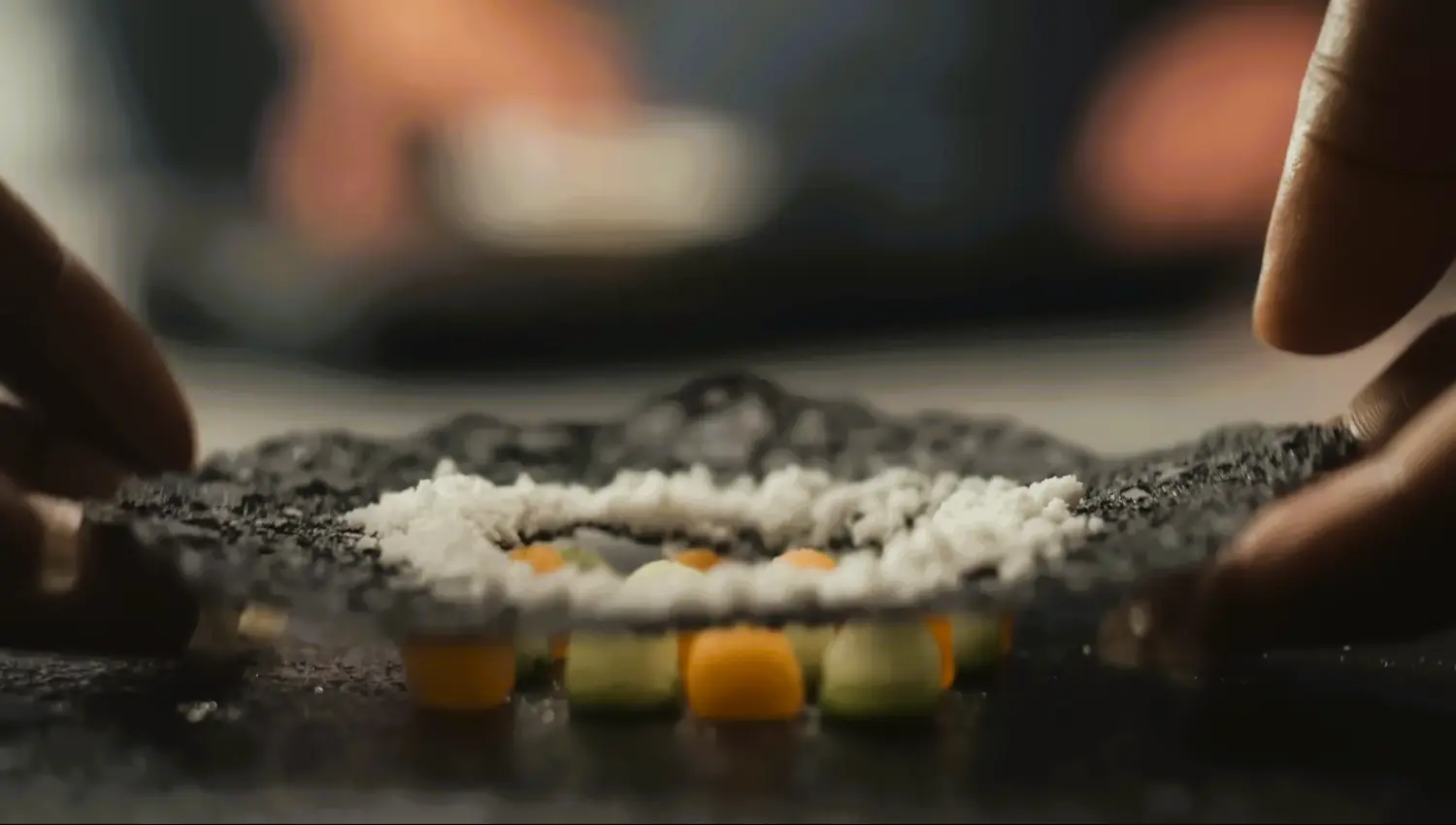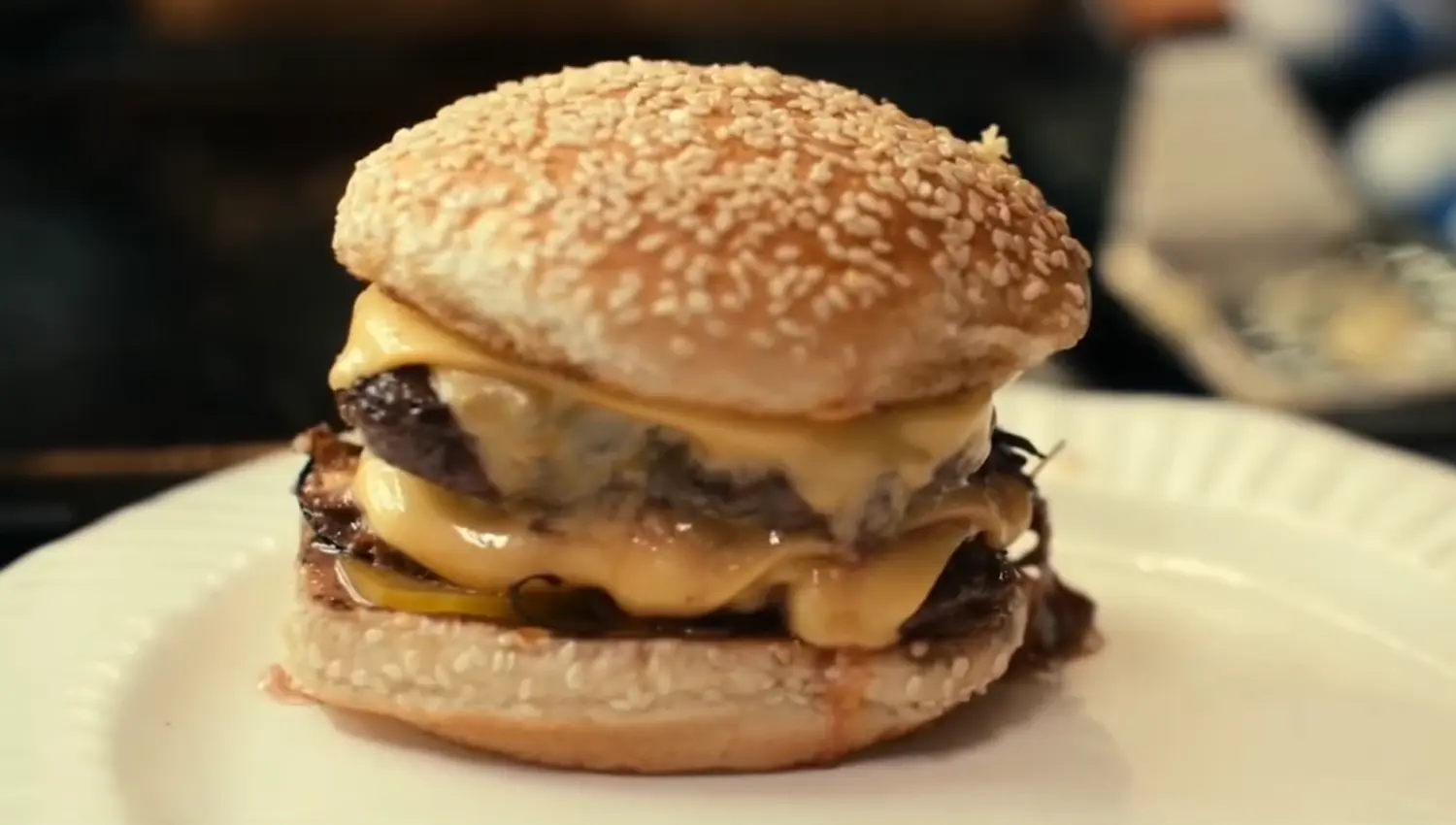Summary
- Every course at The Menu is intentionally crafted by Chef Julian Slowik to convey a specific message about food, art, and societal contrasts.
- The film’s dishes serve as a commentary on the relationship between high-end dining and the commodification of food, reflecting the divide between wealthy patrons and the kitchen staff.
- From the unannounced lemon caviar to the final human s’mores, each dish holds layered meaning that foreshadows Chef Slowik‘s ultimate plan and the fate of the guests.
The Menu Decoded: Courses and Their Meanings
The Menu is structured as an exclusive dining experience at the island’s restaurant, Hawthorn, where twelve guests—wealthy business people, celebrities, and food critics—are treated to a series of meticulously planned courses. Each dish is not merely a meal but a narrative element that tells a story about the state of the food industry, the relationship between creator and consumer, and the personal journey of Chef Julian Slowik. This section breaks down the key courses and their specific meanings.
Lemon Caviar on Raw Oyster With Mignonette

The first dish, served as guests board the boat, is unique in that it is the only course without an explicit explanation from Chef Slowik.
- Ingredients and Presentation:
The dish comprises lemon caviar served on a raw oyster, accompanied by a mignonette sauce. The fresh, tangy lemon adds a distinct sour note that contrasts with the natural brininess of the oyster. - Interpretation:
Although the film offers no direct commentary, the sourness of the lemon is speculated to hint at Chef Slowik‘s own bitterness toward the commercialization of his craft. This dish sets the tone for the evening, subtly alluding to the underlying discontent that will eventually culminate in his dramatic plan. - Audience Reception:
Viewers who noted Tyler’s pretentious explanation of this dish were given an early clue about the dynamic between the chef and his guests. The ambiguity of this course mirrors the complex relationship between true culinary art and the superficial appreciation often shown by the elite.
Amuse Bouche
The Amuse Bouche is the first course served on the island, marking the guests’ arrival at Hawthorn.
- Ingredients and Presentation:
The dish is a small, complimentary bite that features cucumber melon, milk snow, and charred lace. This combination of textures and flavors is designed to intrigue the palate without overwhelming it. - Symbolism:
Traditionally, an Amuse Bouche is not chosen by the diners but is the chef’s signature opening statement. In The Menu, this dish represents Chef Slowik’s absolute control over the dining experience. By serving this course unbidden, he emphasizes that every element of the meal is predetermined, leaving the guests with no choice—mirroring the way in which they have no control over the artifice of their luxurious lives. - Foreshadowing:
This introductory dish also hints that what appears to be an ordinary dining experience is, in fact, a carefully choreographed event where every element, including the guests themselves, is part of a larger narrative.
READ MORE: Why Andarna’s Choice in Onyx Storm Changes Everything
First Course: The Island

The first course, aptly named The Island, is a powerful metaphor that draws on the natural elements surrounding the restaurant.
- Ingredients and Presentation:
Featuring elements such as seaweed and raw scallop, every ingredient in this dish is sourced from the island. - Interpretation:
This course represents the fleeting nature of human life in contrast with the permanence of nature. Chef Slowik draws inspiration from the natural environment to comment on the transient existence of his guests—who, despite their wealth and status, are as ephemeral as the raw ingredients gathered from the surrounding ocean. - Narrative Role:
The Island sets up the overarching theme of the film by reminding the diners (and the audience) that nature, in its raw and untamed form, is indifferent to the luxuries and excesses of human society.
Second Course: Breadless Bread Plate
The second course challenges conventional dining expectations by presenting a dish that is both simple and laden with deeper meaning.
- Ingredients and Presentation:
This course is characterized by the absence of bread, a food historically associated with the impoverished. Instead, the dish is composed solely of a selection of sauces and other savory accompaniments. - Interpretation:
Chef Slowik uses the Breadless Bread Plate to deliver a veiled commentary on the guests at Hawthorn. By eliminating bread—a staple of sustenance for the common people—he suggests that these privileged diners are unworthy of even the simplest food. The dish reflects his disdain for the societal elite, who have lost touch with the true essence of nourishment. - Class Commentary:
As explained in the film, bread and grain have long been the food of the impoverished. This course symbolizes that the guests, with their opulent tastes and detached attitudes, do not deserve the fundamental sustenance that represents a connection to real, unadulterated life.
Third Course: Chicken Tacos With Scissors In It

Arguably one of the most disturbing and significant courses in The Menu, the Chicken Tacos with Scissors serve as a dark reminder of the chef’s troubled past.
- Ingredients and Presentation:
The dish, also known as Memory, includes chicken tacos that are served with a small pair of scissors embedded within. - Interpretation:
Chef Slowik explains that this course is tied to a painful memory from his childhood, when his father’s violence disrupted a family meal. The inclusion of scissors is a literal and symbolic reminder of that moment—signifying a turning point in his life and career. - Revelation and Impact:
Beyond personal catharsis, the dish also exposes the secrets and weaknesses of the guests. Personalized tacos are served with compromising photographs or documents, revealing the hidden sins of each diner. This course not only lays bare the intimate histories of those present but also underscores the intimate connection between food and memory, a central theme in The Menu.
Fourth Course: The Mess
The Mess is a course that embodies the culmination of the pressure and futility experienced by culinary artists.
- Ingredients and Presentation:
This course consists of pressure-cooked vegetables, roasted fillet, potato confit, beef jus, and bone marrow. The dish is served following a grim spectacle where Jeremy, the sous chef, commits suicide. - Interpretation:
The name The Mess encapsulates the inherent chaos and the unattainable pursuit of culinary perfection. Chef Slowik articulates that the relentless pressure to please and to create the perfect dish has driven him and his team to the brink. - Consequences:
The dish is a somber reflection on the cost of perfection and the dehumanizing effects of the high-pressure restaurant industry. It also marks a turning point in the evening, as the tone of the dinner shifts dramatically from artful expression to existential crisis.
READ MORE: Call of Duty Black Ops 6 Season 2 Battle Pass Rewards Revealed
Palate Cleanser: Wild Bergamot and Red Clover Tea

As the courses progress, the Palate Cleanser offers a brief moment of calm before the storm of revelations that follow.
- Ingredients and Presentation:
The tea, made with wild bergamot and red clover, is a traditional palate cleanser that also serves as a moment of reprieve for the guests. - Interpretation:
In The Menu, this course symbolizes the final moments of normalcy before the inevitable collapse. Chef Slowik uses the tea as an ironic gesture—a calm interlude that belies the turbulent events that are to come. - Narrative Function:
The Palate Cleanser not only prepares the diners for the next, more dramatic course but also functions as a dark reminder that appearances can be deceiving; even the most ordinary dish can carry significant weight in the narrative.
Man’s Folly: Dungeness Crab, Umeboshi, Yogurt Whey, Kelp
This course is introduced differently from the others, targeting the gender dynamics among the guests.
- Ingredients and Presentation:
The dish is predominantly seafood-based and is served exclusively to the female guests. It features Dungeness crab, umeboshi, yogurt whey, and kelp—ingredients that evoke the sea and its vast, uncontrollable nature. - Interpretation:
Named Man’s Folly, the course is a culinary exploration of male insecurity and the tendency to flee from responsibility. While the male guests are given an opportunity to escape from the restaurant, the women are left to face the consequences of the decadence and toxicity represented by the dish. - Commentary on Privilege:
The course highlights the contrast between those who embrace the sanctity of food and those who exploit it for superficial gain. The women’s experience of the dish serves as a subtle indictment of the selfishness and frailty of the male diners.
Passard Egg: Hot-Cold, Sweet & Savory Soft-Boiled Egg

Following the turbulent course of Man’s Folly, the Passard Egg is presented as a traditional gourmet dish with a twist.
- Ingredients and Presentation:
The dish features a soft-boiled egg served with crème fraîche and maple syrup. Its presentation is both elegant and deceptively simple. - Interpretation:
In The Menu, the Passard Egg is offered as a reward for the last man caught attempting to escape. The dish symbolizes the ultimate test of character among the guests, singling out those who dare to challenge the status quo. - Symbolism:
The egg’s duality—hot and cold, sweet and savory—mirrors the complex nature of the guests’ own lives, full of contradictions and unexpected turns. Its inclusion in the final stages of the dinner underscores the notion that even amidst chaos, there can be moments of unexpected beauty and delicacy.
READ MORE: The Recruit Season 2: Who Is Attempting To Kill Owen & Lester
Tyler’s Bullst: Terrible Lamb Cooked By An Even Worse Human Being**
In a surprising twist, this course reveals a darker layer of the evening.
- Ingredients and Presentation:
This dish features undercooked lamb and an inedible sauce, presented as a manifestation of Tyler’s own self-perceived connoisseurship. - Interpretation:
The course, known as Tyler’s Bulls**t, reflects Chef Slowik‘s disgust with pretension and the superficiality of those who claim expertise in the culinary arts. - Narrative Impact:
Tyler, who prides himself on his gastronomic knowledge, is humiliated by Chef Slowik for his inability to truly understand the art of cooking. This public shaming culminates in a personal crisis for Tyler, leading to his tragic end. The dish is a stark commentary on the consequences of arrogance in a field where authenticity is paramount.
Birthday Cake
As the evening nears its conclusion, a seemingly normal course is presented that contrasts sharply with the unfolding horror.
- Ingredients and Presentation:
A birthday cake is served to one of the diners at Hawthorn, accompanied by the customary singing of the birthday song. - Interpretation:
The cake represents a moment of surreal levity amid the carnage. Although the diners have been subjected to a series of disturbing revelations, the presentation of the cake serves as a reminder of normalcy and routine in an otherwise chaotic setting. - Narrative Role:
The birthday cake underscores the dark humor pervasive in The Menu, where even moments of celebration are tinged with irony and foreboding. It further emphasizes the dual nature of the dining experience—a blend of exquisite culinary art and the grim reality of the chef’s ultimate plan.
Supplemental Course: A Cheeseburger

Perhaps the most pivotal dish in the narrative, the cheeseburger is not originally part of the planned menu but is requested by Margot, played by Anya Taylor-Joy.
- Ingredients and Presentation:
This course is a double cheeseburger, prepared with two patties, American cheese, and a buttered sesame-seed bun, accompanied by traditional toppings like thinly shaved yellow onion, sliced pickles, and a chosen burger sauce. - Interpretation:
The cheeseburger is symbolic of returning to the roots of authentic cooking. Unlike the elaborate and ostentatious dishes that have characterized the rest of the evening, the cheeseburger represents the pure, unpretentious joy of simple, honest food. - Narrative Significance:
By requesting the cheeseburger, Margot reawakens Chef Slowik‘s passion for genuine culinary art, reminding him of the early days of his career when food was about nourishment and love rather than artifice and exploitation. The cheeseburger becomes the catalyst for Margot’s survival, as Chef Slowik allows her to leave the island—making her the sole survivor of the evening’s tragic events.
READ MORE: The Recruit Season 2: Nathan Fillion’s as CIA Director Alton West
Final Dessert: Human S’Mores
The final course, Human S’Mores, brings the evening to a fiery conclusion.
- Ingredients and Presentation:
The dish is a deconstructed s’mores, incorporating elements that evoke the nostalgic flavors of childhood but presented with a macabre twist. - Interpretation:
Human S’Mores symbolize the final, inescapable act of Chef Slowik‘s grand design. Though s’mores are typically associated with warmth, camaraderie, and innocent fun, the incorporation of this dish in the context of the evening’s events transforms it into a representation of the complete and irreversible destruction of the guests. - Narrative Resolution:
As Chef Slowik ignites the final course, the guests willingly offer their credit cards—a final, ironic tribute to the excess and self-destruction that have defined their lives. The fire that consumes the s’mores also serves as the instrument of their demise, marking the end of the exclusive dining experience and cementing the legacy of Chef Slowik’s revenge.
Theories and Interpretations of The Menu’s Dishes

While the film presents each course with a carefully crafted explanation by Chef Slowik, the layered symbolism of the dishes has sparked numerous theories among audiences.
- The Cheeseburger Debate:
One popular theory is that the cheeseburger may hold a darker meaning beyond its surface appeal. Some speculate that it could be made with human meat, symbolizing the ultimate act of cannibalistic retribution against the elite. Another theory suggests that the cheeseburger was simply poisoned, though this interpretation conflicts with the narrative that Chef Slowik intended to preserve a remnant of genuine food. - Ambiguities in the Lemon Caviar:
The absence of an explanation for the lemon caviar on raw oyster invites viewers to consider the possibility that this dish encapsulates the chef’s hidden history and bitterness. The tartness of the lemon could be a metaphor for the sourness of his experiences in the culinary world, a taste that lingers long after the dish is consumed. - Symbolism in the Breadless Bread Plate:
The choice to omit bread—a staple of sustenance—serves as a potent symbol of exclusion and social commentary. By denying the guests what is fundamental to the nourishment of the many, Chef Slowik criticizes the societal structures that privilege a select few over the masses.
READ MORE: The Menu Cheeseburger: Recipe & How-To Guide
Release Details and Cultural Impact
The Menu, released in 2022, has quickly become a cultural phenomenon, celebrated for its unique blend of horror, dark comedy, and culinary artistry.
- Casting and Production:
Starring Anya Taylor-Joy and Ralph Fiennes, the film has garnered attention for its innovative storytelling and meticulous attention to detail in food preparation. Real-life chefs were brought onto set to ensure that every dish appeared authentic, adding to the film’s immersive quality. - Critical Reception:
Critics have noted the film’s ability to blend high-concept satire with genuine culinary passion, making The Menu a subject of extensive discussion and analysis. The layered meanings behind each dish have led to a rich array of interpretations and discussions among food enthusiasts and cinephiles alike.
Source: ScreenRant
Stay updated with the Latest News and Stories, follow us on our social media platforms.
You can follow us on:
Stay Connected!! Join our Whatsapp Channel















